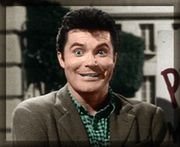 Rob Roy
Rob Roy
1671 - 1734
BY TURNS a thief and extortionist but also a daring hero, few men have been as celebrated in folk legend or literature as Robert Roy MacGregor. He was born in March 1671 in Glen Gyle in the southern Highlands, the third son of Donald Glas, a MacGregor chieftain, and Mary Campbell. From an early age he was given the nickname Ruadh, Gaelic for red because of the colour of his hair, later anglicised to Roy.
The MacGregors were Jacobites who supported the uprising of 1689 against Charles II. Both father and son fought in and survived the battle of Killiecrankie in July of that year. After the rebellion, Rob Roy turned away from politics. He married his cousin Mary of Comar in January of 1693 and, taking his mother's maiden name of Campbell because the name of MacGregor was banned beause of the part they played in the Jacobite uprising, started his own business dealing cattle under the patronage of the Duke of Montrose. He became very successful and earned the lands and title of Laird of Inversnaid in the process.
However, Rob Roy's success was undone in 1711 when, having borrowed the huge sum of £1000 from Montrose, his chief drover stole the money. Although Rob Roy tried to catch the culprit and promised to repay the loan, Montrose declared him to be a thief. He was made bankrupt, his lands were repossessed and he was forced to go on the run. Legend has it that when the soldiers came to evict the MacGregors his wife was branded and raped by the government men.
Rob Roy became an outlaw and pursued a vendetta against the Duke of Montrose. He rustled cattle, stealing the animals and extorting money from farmers to 'protect' them from other rustlers. The feud returned Rob Roy to the political stage by making him a friend of the Duke's enemies, who sheltered him from pursuit. At this time his generosity to the poor, especially those ill-used by the Duke of Montrose, earned him a reputation as a friend of the common man.
A small role in the uprising of 1715 led to charges of treason against Rob Roy, although this seems to have been based more on his reputation than his involvement. Rob Roy continued to plague the Duke of Montrose, who enlisted government support against him. He was captured at Balquhidder but escaped. He was captured again after the Duke of Atholl broke a pledge of safe passage and imprisoned in Dunkeld. Yet again he escaped, this time by bribing the guards.
When Daniel Defoe wrote a fictionalised account of his life in 1723 called Highland Rogue, Rob Roy became a legend in his own lifetime. His popularity with the public led to a pardon for his crimes from George I just as he was about to be transported to the colonies.
His life continued to fascinate artists after his death. The publication of Rob Roy by Sir Walter Scott in 1818 further added to his fame. William Wordsworth wrote a poem called Rob Roy's Grave during a visit to Scotland and he has been the hero of many films.
Rob Roy spent the last years of his life in peace at Balquhidder. He died on 28 December 1734 at his home at the age of 63 as a piper played I Shall Return No More. He was buried on New Year's Day at the Old Kirk Yard in Balquhidder 1735 and was survived by four sons. The inscription on his grave, added in the twentieth century, reads 'MacGregor Despite Them'.
All the above from The Scotsman.com
In 1995 Rob Roy was made into a movie staring Liam Neeson and Jesica Lange. It is one of my all time favorite movies and will make an excellent choice for Tartan Day viewing.
Thursday, April 06, 2006
Tartan Day at the moives
Posted by
Lemuel Calhoon
at
9:39 AM
![]()
Subscribe to:
Comment Feed (RSS)










|